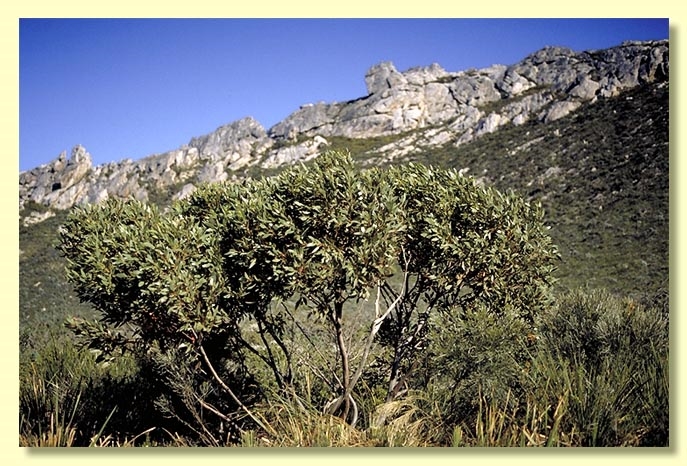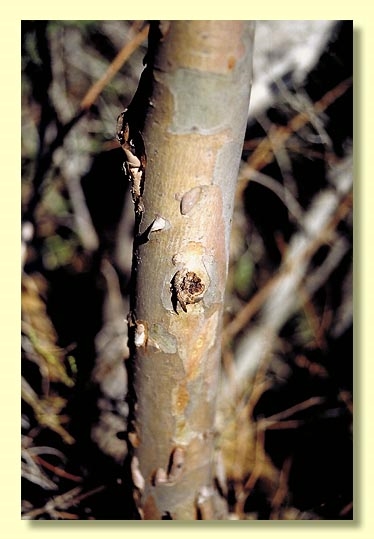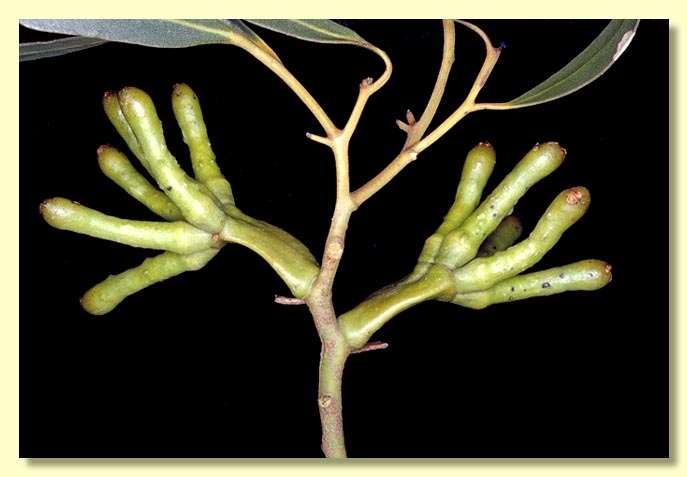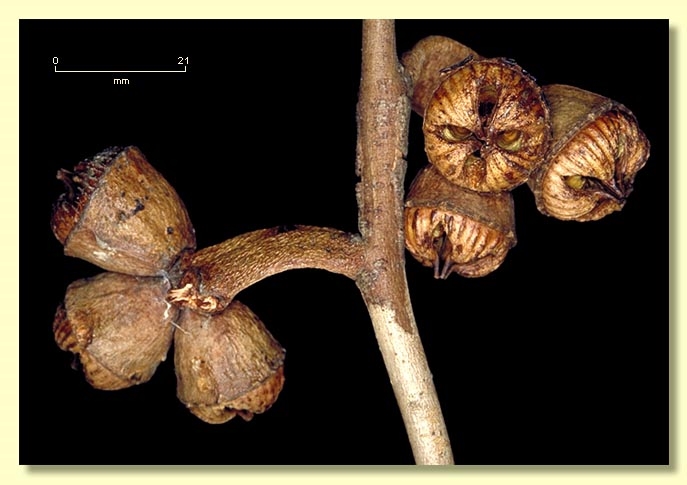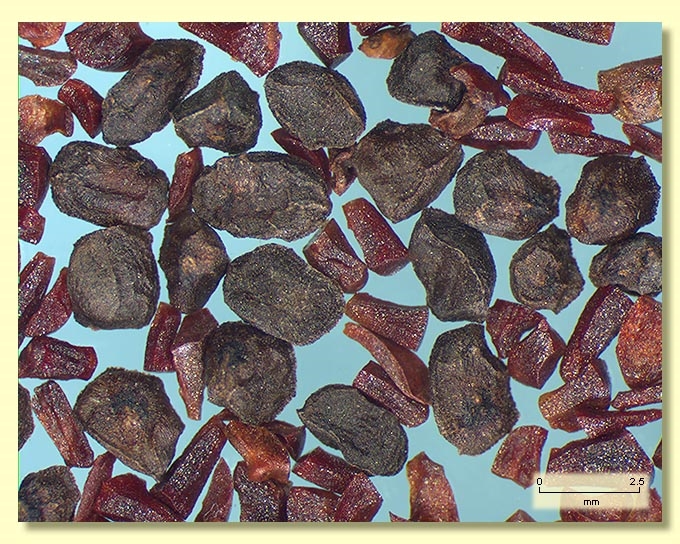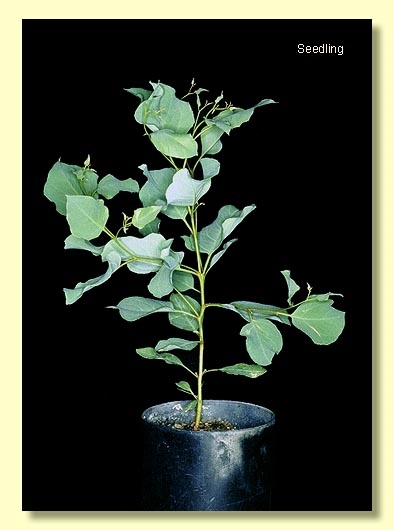Euclid - Online edition
Eucalyptus burdettiana
Eucalyptus | Symphyomyrtus | Bisectae | Hadrotes | Lehmannianae | Liberae
Bark smooth throughout, pale brown-grey and whitish.
Branchlets lacking oil glands in the pith.
Juvenile growth (coppice or field seedlings to 50 cm): stems rounded in cross-section, scabrid at least on lower stem; juvenile leaves always petiolate, alternate, deltoid to ovate, 3.5–8 cm long, 2.5–6 cm wide, green, scabrid on lower leaves.
Adult leaves alternate, petiole 0.7–1.7 cm long; blade lanceolate, (5.7)6.5–9.5 cm long, 1–2.5(3) cm wide, base tapering to petiole, margin entire, apex pointed, concolorous, glossy, mid-green, side veins acute, reticulation moderate to dense, intramarginal vein close to or remote from margin, oil glands few, island and intersectional.
Inflorescence axillary unbranched on broadly flattened spreading or down-turned peduncles 2.5–5 cm long, buds 7, 9 or 11 per umbel, sessile. Mature buds elongated with sparsely scattered warts (2–5.8 cm long, 0.4–1.3 cm wide), scar present, operculum horn-shaped, ca 3–4 times as long as the hypanthium and with blunt warty tip, stamens erect, anthers narrowly oblong, versatile, dorsifixed, dehiscing by longitudinal slits, style long and straight, stigma rounded, locules 3 or 4, the placentae each with 6 vertical rows of ovules with a medial gap. Flowers yellow-green.
Fruit on spreading or down-turned peduncles, sessile, campanulate to cupular, 1.9–2.7 cm long, 2–2.5 cm wide, dehiscing by elliptical holes that form when the 3 or 4 valves split along the sutures but remain connected apically, disc more or less striate, covering the valves.
Seeds black, 2–4 mm long, ovoid to angularly so, dorsal surface shallowly reticulate, margin sometimes narrowly and partially flanged, hilum ventral.
Cultivated seedlings (measured at node 10): cotyledons Y-shaped (bisected), robust; stems rounded in cross-section except near tips where three-sided, scabrid at least to node 11; leaves always petiolate, opposite for 3 to 6 nodes then alternate, ovate to orbicular, 3.5–5.5 cm long, 2.5–5 cm wide, margins undulate, discolorous, green, scabrid. Scabridity due to bristle-glands.
Flowering has been recorded in March, April, June and August.
A mallee or shrub endemic to Western Australia, known only from the sides of East Mount Barren in Fitzgerald River National Park. The bark is smooth, adult leaves glossy, green and the buds and fruit large and easily seen in the crown. Buds are 2–5.8 cm long with long yellow-green stamens.
Eucalyptus burdettiana belongs in Eucalyptus subgenus Symphyomyrtus section Bisectae subsection Hadrotes because the cotyledons are coarsely bisected, buds have an operculum scar, a long (inner) operculum and erect stamens, fruit are large, thick-rimmed and held rigidly. There are 12 species in subsection Hadrotes, two species (E. macrandra, E. cornuta ) have oil glands in the pith whilst 10 species lack these oil glands. Together these 10 species form series Lehmannianae, a group further characterised by having scabrid seedlings and fruit with exserted valves that remain fused at their tips after seed is shed, a feature shared with the more distantly related E. cornuta.
Of the ten species in series Lehmannianae four, E. newbeyi, E. burdettiana, E. talyuberlup, and E. megacornuta, have buds and fruit in each umbel basally free (subseries Liberae) whilst the other six species, E. lehmannii, E. conferruminata, E. arborella, E. mcquoidii, E. sinuosa and E. retusa have the buds (and fruit) in each axillary cluster fused basally (subseries Conjunctae). The scabridity of the seedling leaves of these ten species is due to emergent multicellular oil glands.
E. burdettiana, with almost parallel-sided, slightly warty opercula, and E. talyuberlup, with smooth opercula, are both mallees (lignotuberous). E. newbeyi and E. megacornuta are both mallets (lack lignotubers), the former with smooth buds and the latter with extremely warty large buds.
E. burdettiana has much wider fruit (2-2.5 cm wide) than E. talyuberlup (1.3-1.8 cm wide), and the latter is more widely distributed and more abundant, occurring from the Stirling Range to the Kalgan River.
E. burdettiana is listed as "Endangered" under the Australian Government Environment Protection and Biodiversity Conservation Act 1999 (EPBC Act). Further information may be found at this web address:
http://www.environment.gov.au/cgi-bin/sprat/public/sprat.pl

